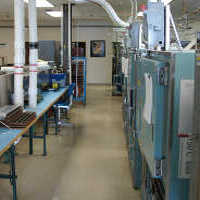Accelerated Bias Aging Test
Accelerated bias aging tests determine the reliability and quality of semiconductor devices. This includes testing for:
- High Temperature Operating Life (HTOL Test)
- High Temperature Operating Bias (HTOB Test)
- High Temperature Reverse Bias (HTRB Test)
- High Temperature Gate Bias (HTGB Test)
- Operating Life Temperature (OLT Test)
- Burn-in
Accelerated bias aging testing combines elevated temperature and voltage to accelerate various failure mechanisms in semiconductors. This process simulates years of real-life operation in just hours or days. Regression curves can be generated from the data to plot failures versus time and temperature. These curves are used to derive the device FIT (Failures-in-Time) rates. FIT rates are indicators of device reliability and are used to predict device performance at the use-condition, i.e. device operating temperature and voltage stress. One FIT implies one failure per 1e9 device-hours of operation.
Oneida Research Services has the ability to perform accelerated bias aging up to 200°C and up to 1700 Vdc. ORS also has AC input capability to age devices dynamically, thus more closely resembling actual use conditions. Our unique dedicated chambers have internal socketed DUT-boards and externally mounted, application-configurable interface cards with built-in capability for real-time per-device monitoring and a backup chart recorder to monitor chamber temperature and power supply voltage(s) as required. Additionally, we offer an option of monitoring and storing snapshot data at various intervals through the use of our data acquisition systems. This provides more detailed information about when a device fails and thus a better estimate of the FIT rate.
- Accelerated Bias Aging
- AEC-Q100
- AEC-Q101
- JESD22-A108
- MIL-STD-202 Method 108
- MIL-STD-883 Method 1007
- MIL-STD-750 Method 1026
- MIL-STD-750 Method 1039
- MIL-STD-750 Method 1038
- MIL-STD-750 Method 1040
- MIL-STD-750 Method 1042
- MIL-STD-750 Method 1048
- MIL-STD-883 Method 1005
- MIL-STD-883 Method 1015
- MIL-STD-883 Method 1030
- MIL-STD-883 Method 1016
- MIL-STD-883 Method 1033
HTOL Testing
It is important to find the right operating life test for your components. HTOL testing, or High Temperature Operating Life testing, elevates temperature and voltage to apply stress to an integrated circuit. This high temperature aging test is used for qualification purposes.
Burn-in Testing
Generally, burn-in is performed for a shorter period of time and is a certification test for devices that were previously qualified using HTOL or HTOB. An Intermittent Operating Life testing or OLT test is another method to determine the reliability and life expectancy of a device.
HTRB Testing
High Temperature Reverse Bias testing, one of the most common reliability tests, verifies that power devices meet performance requirements. The HTRB tests evaluate stability under high drain-source bias.
As with all testing conducted at ORS, accelerated bias aging is performed with the utmost care and under tightly controlled conditions by our experienced team of professionals.




